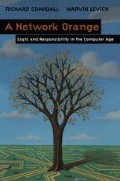Abstract
The myth of technological and political and social inevitability is a powerful tranquilizer of the conscience. Its service is to remove responsibility from the shoulders of everyone who truly believe in it. But in fact, there are actors!
Access this chapter
Tax calculation will be finalised at checkout
Purchases are for personal use only
Preview
Unable to display preview. Download preview PDF.
References
Bajaj, S., Cheung, N., Hayward, G., and Tsai, Y. 1996. “High-speed ATM/SONET Infra-structure Research in ADTNet”. IEEE Network 10(4), pp. 18–29.
Himmelfarb, G. 1997. “Revolution in the Library”. The Key Reporter 62 (Spring), pp. 1–3.
Huxley, A. 1962. “Words and Their Meanings”. In The Importance of Language, ed. M. Black. Englewood Cliffs, NJ: Prentice-Hall.
Lea, M., ed. 1992. Contexts of Computer-Mediated Communication. Hempstead: Harvester Wheatsheaf.
Lloyd, C. 1993. London Sunday Times, November 28.
Nadel, L., et al., eds. 1989. Neural Connections, Mental Computation. Cambridge, MA: M.I.T. Press.
Oppenheimer, T. 1997. “The Computer Delusion”. Atlantic Monthly, July pp. 1–20.
Peters, R. 1973. “Reason and Habit: The Paradox of Moral Education”. In Philosophy and Education. Boston: Allyn and Bacon.
Pring, R. 1971. “Curriculum Integration”. Proceedings of the Philosophy of Education Society of Great Britain V(2), pp. 170–200.
Reid, E. 1991. “Electropolis: Communication and Community on Internet Relay Chat”. Honors Thesis, Department of History, University of Melbourne, Australia.
Rheingold, H. 1993. The Virtual Community: Homesteading on the Electronic Frontier. Reading, MA: Addison-Wesley.
Rutter, D. 1984. Looking and Seeing: The Role of Visual Communication in Social Interaction. Chicester: Wiley.
Shannon, C. 1948. “A Mathematical Theory of Communication”. Bell Systems and Technology Journal 27 (July-August).
Shepherd, D., Scott, A., Rodden T., and Vin, H. 1996. “Quality-of-Service Support for Multimedia Applications”. IEEE Multimedia, Fall, pp. 78–82.
Tuman, M. 1992. Word Perfect: Literacy in the Computer Age. Pittsburgh: University of Pittsburgh Press.
Weizenbaum, J. 1976. Computer Power and Human Reason. San Francisco: Freeman.
Rights and permissions
Copyright information
© 1998 Springer-Verlag New York, Inc.
About this chapter
Cite this chapter
Crandall, R., Levich, M. (1998). A Network Orange. In: A Network Orange. Springer, New York, NY. https://doi.org/10.1007/978-1-4612-2172-2_4
Download citation
DOI: https://doi.org/10.1007/978-1-4612-2172-2_4
Publisher Name: Springer, New York, NY
Print ISBN: 978-1-4612-7443-8
Online ISBN: 978-1-4612-2172-2
eBook Packages: Springer Book Archive

